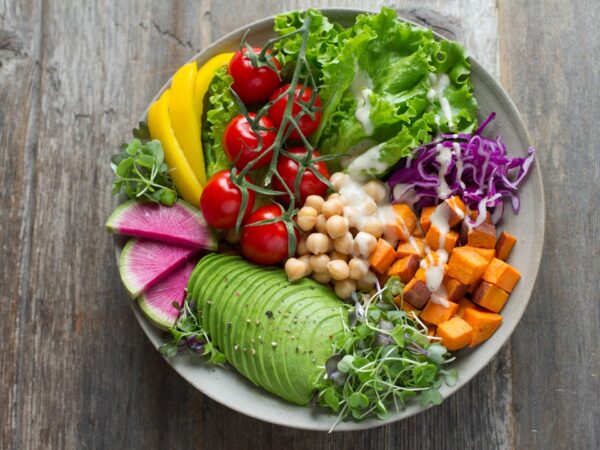
Fueling Your Body Right: A Guide to Healthy Eating with MyPlate from the U.S. Department of Agriculture
Healthy eating is essential for maintaining good overall health and preventing chronic diseases. It provides the body with the necessary nutrients, vitamins, and minerals to function properly. A balanced diet can help maintain a healthy weight, boost energy levels, improve mood, and reduce the risk of developing various health conditions such as heart disease, diabetes, and certain types of cancer.
One tool that can help individuals make healthier food choices is MyPlate. MyPlate is a visual representation of a healthy plate that was developed by the United States Department of Agriculture (USDA). It provides a simple and easy-to-understand guide for building a balanced meal by dividing the plate into different food groups.
Key Takeaways
- MyPlate is a visual guide that helps individuals make healthy food choices and maintain a balanced diet.
- The five food groups (fruits, vegetables, grains, protein, and dairy) provide essential nutrients for optimal health.
- Building a balanced plate involves filling half with fruits and vegetables, a quarter with grains, and a quarter with protein, along with a serving of dairy.
- Portion control is important for maintaining a healthy weight and involves measuring serving sizes and avoiding oversized portions.
- Healthy eating on a budget can be achieved by planning meals, buying in bulk, and choosing affordable options from each food group.
Understanding MyPlate and Its Importance in Healthy Eating
MyPlate was introduced in 2011 as a replacement for the Food Pyramid. The purpose of MyPlate is to simplify the message of healthy eating and make it more accessible to the general public. It is designed to be a visual representation of what a healthy meal should look like.
The main goal of MyPlate is to encourage individuals to make healthier food choices and build a balanced plate. It emphasizes the importance of consuming a variety of foods from all five food groups: fruits, vegetables, grains, protein, and dairy. By following the guidelines provided by MyPlate, individuals can ensure that they are getting all the necessary nutrients their bodies need for optimal health.
The Five Food Groups and Their Nutritional Benefits
The five food groups that make up MyPlate are fruits, vegetables, grains, protein, and dairy. Each food group provides different essential nutrients that are important for overall health.
Fruits are an excellent source of vitamins, minerals, and fiber. They are low in calories and high in antioxidants, which help protect the body against chronic diseases. Consuming a variety of fruits can help improve digestion, boost the immune system, and promote healthy skin.
Vegetables are packed with essential vitamins, minerals, and fiber. They are low in calories and high in nutrients, making them an important part of a healthy diet. Eating a variety of vegetables can help reduce the risk of chronic diseases, improve digestion, and support healthy weight management.
Grains provide the body with energy and are a good source of fiber, vitamins, and minerals. Whole grains, such as brown rice, whole wheat bread, and quinoa, are especially beneficial as they contain all parts of the grain and provide more nutrients compared to refined grains.
Protein is essential for building and repairing tissues, producing enzymes and hormones, and supporting a healthy immune system. Good sources of protein include lean meats, poultry, fish, beans, nuts, and seeds.
Dairy products are a great source of calcium, which is important for strong bones and teeth. They also provide protein and other essential nutrients. It is important to choose low-fat or fat-free options to reduce saturated fat intake.
Tips for Building a Balanced Plate
| Tips for Building a Balanced Plate | Description |
|---|---|
| Fill half your plate with vegetables and fruits | Vegetables and fruits are low in calories and high in nutrients, making them an important part of a balanced plate. |
| Choose lean protein sources | Protein is important for building and repairing tissues, but it’s important to choose lean sources like chicken, fish, beans, and tofu to avoid excess saturated fat. |
| Incorporate whole grains | Whole grains like brown rice, quinoa, and whole wheat bread provide fiber and important nutrients that refined grains lack. |
| Include healthy fats | Healthy fats like avocado, nuts, and olive oil can help improve heart health and provide satiety. |
| Limit processed and sugary foods | Processed and sugary foods can be high in calories and low in nutrients, so it’s important to limit them in a balanced diet. |
Building a balanced plate using MyPlate guidelines is simple and can be done by following a few key tips:
1. Fill half your plate with fruits and vegetables: Aim to include a variety of colorful fruits and vegetables in your meals. These should make up half of your plate.
2. Make half your grains whole grains: Choose whole grain options such as whole wheat bread, brown rice, and whole grain pasta. These provide more nutrients compared to refined grains.
3. Include lean protein sources: Opt for lean meats such as chicken breast or turkey, fish, beans, nuts, or tofu as your protein source.
4. Don’t forget about dairy: Include low-fat or fat-free dairy products such as milk, yogurt, or cheese in your meals.
By following these tips, you can ensure that your plate is balanced and provides all the necessary nutrients for optimal health.
Portion Control: How Much Should You Eat?
Portion control is an important aspect of healthy eating. Even if you are consuming nutritious foods, eating too much can lead to weight gain and other health issues. It is important to be mindful of portion sizes and listen to your body’s hunger and fullness cues.
One way to control portion sizes is by using measuring cups or a food scale to measure your food. This can help you become more aware of how much you are actually eating and prevent overeating.
Another tip is to use smaller plates and bowls. Research has shown that people tend to eat more when they are served larger portions. By using smaller plates and bowls, you can trick your brain into thinking that you are eating more than you actually are.
It is also important to eat slowly and savor each bite. This allows your brain to register when you are full and prevents overeating. Put your fork down between bites and take the time to enjoy your meal.
Healthy Eating on a Budget: Making the Most of Your Grocery List
Eating healthy doesn’t have to break the bank. With some planning and smart shopping, it is possible to eat nutritious meals on a budget.
One tip for grocery shopping on a budget is to plan your meals in advance. Take some time each week to plan out your meals and make a grocery list based on those meals. This will help you avoid impulse purchases and ensure that you have all the necessary ingredients for healthy meals.
Another tip is to buy in bulk. Buying items such as grains, beans, nuts, and seeds in bulk can save you money in the long run. These items have a long shelf life and can be used in a variety of recipes.
It is also important to compare prices and look for sales or discounts. Check out different grocery stores in your area and compare prices for the items on your list. Look for sales or discounts on healthy items such as fruits, vegetables, and lean meats.
Eating Out: Making Smart Choices at Restaurants
Eating out can be challenging when trying to eat healthy, but it is possible to make smart choices even when dining at restaurants.
One tip is to check the menu online before going to the restaurant. This will allow you to plan ahead and choose healthier options. Look for dishes that are grilled, baked, or steamed instead of fried. Choose dishes that are made with lean meats or fish and include plenty of vegetables.
Another tip is to ask for modifications. Most restaurants are willing to accommodate special requests such as substituting fries for a side salad or dressing on the side. Don’t be afraid to ask for healthier options or modifications to make your meal more nutritious.
It is also important to practice portion control when eating out. Restaurant portions are often larger than what we need, so consider sharing a meal with a friend or taking half of it home for later.
Snacking with MyPlate: Choosing Healthy Options
Snacking can be a part of a healthy diet if done right. It is important to choose nutritious snacks that provide energy and essential nutrients.
One tip for choosing healthy snacks is to opt for whole foods such as fruits, vegetables, nuts, and seeds. These snacks are packed with vitamins, minerals, and fiber and can help keep you full between meals.
Another tip is to plan your snacks in advance. Take some time each week to prepare healthy snacks and portion them out into individual servings. This will help prevent mindless snacking and ensure that you have nutritious options readily available.
It is also important to listen to your body’s hunger cues when snacking. Snack when you are truly hungry and stop when you are satisfied. Avoid snacking out of boredom or as a way to cope with emotions.
Hydration: The Importance of Drinking Enough Water
Staying hydrated is crucial for overall health and well-being. Water is essential for numerous bodily functions, including digestion, nutrient absorption, temperature regulation, and waste removal.
Drinking enough water can help maintain proper hydration, which is important for optimal physical and mental performance. It can also help prevent dehydration, which can lead to fatigue, headaches, and poor concentration.
Aim to drink at least 8 cups (64 ounces) of water per day. However, individual needs may vary depending on factors such as activity level, climate, and overall health. It is important to listen to your body’s thirst cues and drink water throughout the day.
If you struggle to drink enough water, try carrying a reusable water bottle with you and sipping on it throughout the day. You can also flavor your water with fresh fruits or herbs to make it more enjoyable.
Mindful Eating: Listening to Your Body’s Hunger and Fullness Cues
Mindful eating is a practice that involves paying attention to the present moment while eating and listening to your body’s hunger and fullness cues.
One tip for practicing mindful eating is to eat without distractions. Avoid eating in front of the TV or computer and focus on your meal. Take the time to savor each bite and pay attention to the flavors, textures, and smells of your food.
Another tip is to eat slowly and chew your food thoroughly. This allows your brain to register when you are full and prevents overeating. Put your fork down between bites and take the time to enjoy your meal.
It is also important to listen to your body’s hunger cues. Eat when you are truly hungry and stop when you are satisfied. Avoid eating out of boredom or as a way to cope with emotions.
Building a Sustainable and Healthy Eating Plan for Life
Creating a sustainable and healthy eating plan is important for long-term success. It is not about following a strict diet or depriving yourself of certain foods, but rather about making small, sustainable changes that you can maintain for life.
One tip for building a sustainable eating plan is to focus on whole, unprocessed foods. These foods are nutrient-dense and provide the body with the necessary nutrients for optimal health. Include a variety of fruits, vegetables, whole grains, lean proteins, and healthy fats in your meals.
Another tip is to practice moderation. It is okay to enjoy your favorite foods in moderation. Allow yourself to indulge occasionally, but make sure that the majority of your meals are balanced and nutritious.
It is also important to be flexible and adaptable. Life happens, and there will be times when it is not possible to eat perfectly. Instead of beating yourself up over it, focus on making healthier choices whenever possible and getting back on track.
In conclusion, healthy eating is essential for maintaining good overall health and preventing chronic diseases. MyPlate is a useful tool that can help individuals make healthier food choices and build a balanced plate. By following the guidelines provided by MyPlate and incorporating tips such as portion control, mindful eating, and hydration, individuals can create a sustainable and healthy eating plan for life. Remember to listen to your body’s hunger and fullness cues, choose nutritious options, and enjoy your meals in moderation.
If you’re interested in learning more about healthy eating and nutrition, you might want to check out this informative article on Wave Magnets. They have a great resource that complements the MyPlate guidelines provided by the U.S. Department of Agriculture. This article, found at https://wavemagnets.com/sample-page/, offers valuable insights and tips on how to create a balanced diet that aligns with MyPlate’s recommendations. It’s a must-read for anyone looking to improve their eating habits and overall well-being.
FAQs
What is MyPlate?
MyPlate is a visual representation of the five food groups that make up a healthy diet. It was created by the U.S. Department of Agriculture (USDA) to help people make healthier food choices.
What are the five food groups represented in MyPlate?
The five food groups represented in MyPlate are fruits, vegetables, grains, protein foods, and dairy.
What is the recommended serving size for each food group?
The recommended serving size for each food group varies depending on age, gender, and level of physical activity. The USDA provides a chart with recommended daily servings for each food group based on these factors.
How can MyPlate help me make healthier food choices?
MyPlate can help you make healthier food choices by providing a visual representation of the five food groups and their recommended serving sizes. By following the recommendations, you can ensure that you are getting a balanced diet that includes all the necessary nutrients.
Is MyPlate suitable for people with dietary restrictions?
MyPlate can be adapted to meet the needs of people with dietary restrictions. For example, people who are lactose intolerant can choose non-dairy sources of calcium, such as fortified soy milk or leafy greens. People who follow a vegetarian or vegan diet can choose plant-based sources of protein, such as beans, nuts, and tofu.
Is MyPlate suitable for children?
MyPlate is suitable for children, but the recommended serving sizes may need to be adjusted based on their age and level of physical activity. The USDA provides a chart with recommended daily servings for each food group based on age and gender. Parents can use this chart to ensure that their children are getting a balanced diet.


















